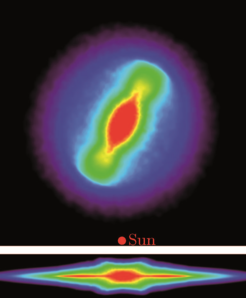One long Milky Way bar and bulge
The Milky Way’s bar also gets thinner away from the centre of the galaxy. Near the end of the bar it becomes so thin that the scientists have termed the bar super-thin, and believe that the thinness of this new component is probably related to younger stars that were born with low velocities about one billion years ago.

Mapping the Milky Way is difficult because of the position of our Sun near the spiral arms in the Galactic plane, where dense clouds of gas and dust obscure our view towards the inner regions, as seen in Fig 1. Because of this, the study combined data from four large surveys of the Galaxy: UKIDSS, VVV, 2MASS, and GLIMPSE (see Notes), which were all taking data at near-infrared wavelengths, where the Galactic dust clouds become more transparent.
The combination of these surveys was used to make the dust-corrected view from the Sun towards the Milky Way's inner regions in Fig 2. The asymmetry seen in the figure is a result of the barred shape of the bulge and the bar. Both are oriented so their nearer part is closer to the Sun on the left of the image.

This image shows the surface density of stars in the Milky Way as seen from the Sun, taken from three different surveys and corrected for extinction. The bulge is the thicker region near the center; it is asymmetric because it is barred. The asymmetry in the disk towards the left of the image is due to the thinner long bar outside the bulge.
“The new surveys that have been taking measurements in the bar region over the past few years are invaluable since they peer through the dust over a much wider area than before,” explains Christopher Wegg, lead author and post-doctoral researcher at MPE. “They therefore allow us to make maps of the shape of the whole bar and bulge of the Milky Way”.
In the study, these data were then compared to model galaxies with different shapes; a view of the best fitting galaxy from above is shown in Fig 3. Unlike some previous studies, the bar outside the bulge is aligned with the central bulge. This, together with the fact that the bulge smoothly transitions to the bar, leads the scientists to conclude that the bulge and bar are one innately connected structure.

The top panel shows the model that best fits the distances and positions of the stars shown in figure 1, as seen from above. The central bulge region and the longer bar are seen to be one aligned structure. The lower panel shows the same model viewed from the side. From this view the bulge has a distinctive shape also seen in other barred galaxies.
“While previously it could be thought that the bulge and the bar are different components of the Milky Way, our new study shows that they really are the inner and outer parts of the same structure”, says Ortwin Gerhard, coauthor and leader of the dynamics group at MPE. “There is little evidence now that the Milky Way contains a bulge formed early-on before the Galactic disk”.
The scientists also found that the bar is confined to the mid-plane of our Galaxy to within 0.1%: 15 light-years over its entire 15,000 light-year length. “It really surprised us that we could measure this level of alignment between the bar and the rest of the Milky Way disk out to the Sun, and that the inner Milky Way appears so unperturbed,” they say. “We need to go back to our galaxy formation models to see if this can be reproduced.”
Notes:
UKIDSS is the United Kingdom Infrared Deep Sky Survey; VVV the Vista Variables in the Via Lactea programme; 2MASS the Two Micron All Sky Survey; and GLIMPSE the Galactic Legacy Infrared Mid-Plane Survey Extraordinaire.














